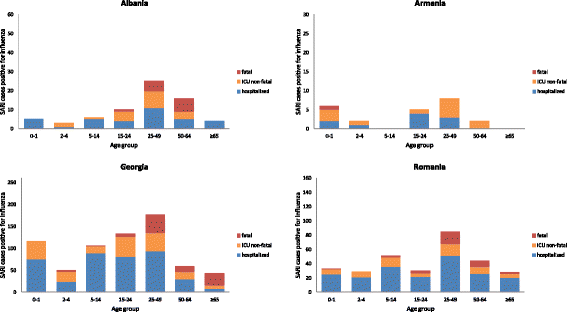Surveillance for severe acute respiratory infections (SARI) in hospitals in the WHO European region - an exploratory analysis of risk factors for a severe outcome in influenza-positive SARI cases
- PMID: 25567701
- PMCID: PMC4314771
- DOI: 10.1186/s12879-014-0722-x
Surveillance for severe acute respiratory infections (SARI) in hospitals in the WHO European region - an exploratory analysis of risk factors for a severe outcome in influenza-positive SARI cases
Abstract
Background: The 2009 H1N1 pandemic highlighted the need to routinely monitor severe influenza, which lead to the establishment of sentinel hospital-based surveillance of severe acute respiratory infections (SARI) in several countries in Europe. The objective of this study is to describe characteristics of SARI patients and to explore risk factors for a severe outcome in influenza-positive SARI patients.
Methods: Data on hospitalised patients meeting a syndromic SARI case definition between 2009 and 2012 from nine countries in Eastern Europe (Albania, Armenia, Belarus, Georgia, Kazakhstan, Kyrgyzstan, Romania, Russian Federation and Ukraine) were included in this study. An exploratory analysis was performed to assess the association between risk factors and a severe (ICU, fatal) outcome in influenza-positive SARI patients using a multivariate logistic regression analysis.
Results: Nine countries reported a total of 13,275 SARI patients. The majority of SARI patients reported in these countries were young children. A total of 12,673 SARI cases (95%) were tested for influenza virus and 3377 (27%) were laboratory confirmed. The majority of tested SARI cases were from Georgia, the Russian Federation and Ukraine and the least were from Kyrgyzstan. The proportion positive varied by country, season and age group, with a tendency to a higher proportion positive in the 15+ yrs age group in six of the countries. ICU admission and fatal outcome were most often recorded for influenza-positive SARI cases aged > 15 yrs. An exploratory analysis using pooled data from influenza-positive SARI cases in three countries showed that age > 15 yrs, having lung, heart, kidney or liver disease, and being pregnant were independently associated with a fatal outcome.
Conclusions: Countries in Eastern Europe have been able to collect data through routine monitoring of severe influenza and results on risk factors for a severe outcome in influenza-positive SARI cases have identified several risk groups. This is especially relevant in the light of an overall low vaccination uptake and antiviral use in Eastern Europe, since information on risk factors will help in targeting and prioritising vulnerable populations.
Figures
References
-
- Influenza surveillance in the WHO European Region [http://www.euro.who.int/en/health-topics/communicable-diseases/influenza...]
-
- To KK, Wong SS, Li IW, Hung IF, Tse H, Woo PC, Chan KH, Yuen KY. Concurrent comparison of epidemiology, clinical presentation and outcome between adult patients suffering from the pandemic influenza A (H1N1) 2009 virus and the seasonal influenza A virus infection. Postgrad Med J. 2010;86(1019):515–521. doi: 10.1136/pgmj.2009.096206. - DOI - PMC - PubMed
-
- Gilca R, De Serres G, Boulianne N, Ouhoummane N, Papenburg J, Douville-Fradet M, Fortin E, Dionne M, Boivin G, Skowronski DM. Risk factors for hospitalization and severe outcomes of 2009 pandemic H1N1 influenza in Quebec, Canada. Influenza Other Respi Viruses. 2011;5(4):247–255. doi: 10.1111/j.1750-2659.2011.00204.x. - DOI - PMC - PubMed
MeSH terms
Grants and funding
LinkOut - more resources
Full Text Sources
Other Literature Sources
Medical




